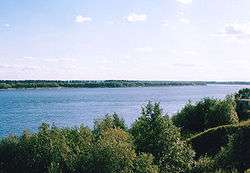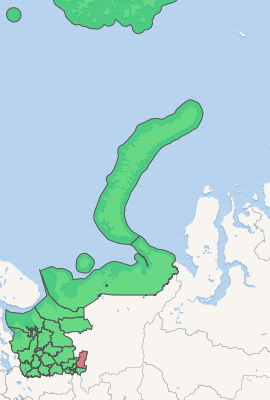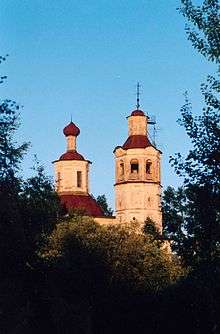Lensky District, Arkhangelsk Oblast
Lensky District (Russian: Ле́нский райо́н) is an administrative district (raion), one of the twenty-one in Arkhangelsk Oblast, Russia.[1] As a municipal division, it is incorporated as Lensky Municipal District.[8] It is located in the southeast of the oblast and borders with Udorsky District of the Komi Republic in the north, Syktyvdinsky, Ust-Vymsky, and Sysolsky Districts, also of the Komi Republic, in the east, Vilegodsky District in the south, and with Kotlassky and Krasnoborsky Districts in the west. The area of the district is 10,700 square kilometers (4,100 sq mi).[4] Its administrative center is the rural locality (a selo) of Yarensk.[3] Population: 13,362 (2010 Census);[5] 16,071 (2002 Census);[10] 20,488 (1989 Census).[11] The population of Yarensk accounts for 27.4% of the district's total population.[5]
Lensky District Ленский район | |
|---|---|
 Vychegda River, near the village of Irta | |
.png) Flag  Coat of arms | |

Location of Lensky District in Arkhangelsk Oblast | |
| Coordinates: 61°33′N 45°56′E | |
| Country | Russia |
| Federal subject | Arkhangelsk Oblast[1] |
| Established | June 1, 1924[2] |
| Administrative center | Yarensk[3] |
| Area | |
| • Total | 10,700 km2 (4,100 sq mi) |
| Population | |
| • Total | 13,362 |
| • Estimate (2018)[6] | 11,227 (-16%) |
| • Density | 1.2/km2 (3.2/sq mi) |
| • Urban | 34.3% |
| • Rural | 65.7% |
| Administrative structure | |
| • Administrative divisions | 1 Urban-type settlements with jurisdictional territory, 9 Selsoviets |
| • Inhabited localities[3] | 1 Urban-type settlements[7], 146 Rural localities |
| Municipal structure | |
| • Municipally incorporated as | Lensky Municipal District[8] |
| • Municipal divisions[8] | 1 Urban settlements, 3 Rural settlements |
| Time zone | UTC+3 (MSK |
| OKTMO ID | 11635000 |
| Website | http://www.yarensk.ru/ |
Etymology
The name of the district originates from the selo of Lena, which at the formation of the district in 1924 was intended to be the administrative center. While the plans to move the administrative center to Lena had never been realized, the name remained unchanged.[12]
History
The area was originally populated by the Finno-Ugric peoples and then colonized by the Novgorod Republic. After the fall of Novgorod, the area became a part of the Grand Duchy of Moscow. Yarensk is first mentioned in the chronicles (as Yerensky Gorodok) in 1374. In 1606, Yarensky Uyezd was formed, and Yarensk became one of the most important towns in the North of Russia.
In the course of the administrative reform carried out in 1708 by Peter the Great, the area was included into Siberia Governorate, and in 1719 transferred to Archangelgorod Governorate.[13] In 1780, the governorate was abolished and transformed into Vologda Viceroyalty. At the same time, Yarensk was granted town rights. In 1918, Yarensky Uyezd was transferred to the newly formed Northern Dvina Governorate, and in 1924 the uyezds were abolished in favor of the new divisions, the districts (raions). Lensky District was formed on June 1, 1924. The idea was to move the administrative center of the district from Yarensk to the selo of Lena, but the logistics came out to be too difficult, and the administration remained in Yarensk.[12]
In the following years, the district remained within the same borders, but the first-level administrative division of Russia kept changing. In 1929, Northern Dvina Governorate was merged into Northern Krai, which in 1936 was transformed into Northern Oblast. In 1937, Northern Oblast was split into Arkhangelsk Oblast and Vologda Oblast. Lensky District remained in Arkhangelsk Oblast ever since.
Geography

The district is located on both banks of the Vychegda and belongs almost exclusively to the basins of the Vychegda and its major tributaries. The main (right-hand) Northern Dvina tributary which flows through the district is the Yarenga. Minor parts of the district belong to the basins of a tributary of the Northern Dvina, the Uftyuga (west), and the Vashka River, a tributary of the Mezen River (northwest). The source of the Pinega is in fact located in Krasnoborsky District. The whole area of the district drains into the White Sea.
Almost the whole of the district is covered by coniferous forests (taiga).
Divisions
Administrative divisions
As an administrative division, the district is divided into nine selsoviets and one urban-type settlement with jurisdictional territory (Urdoma).[3] The following selsoviets have been established (the administrative centers are given in parentheses):[3]
- Irtovsky (Irta)
- Kozminsky (Kozmino)
- Lensky (Lena)
- Ryabovsky (Ustye)
- Safronovsky (Yarensk)
- Slobodchikovsky (Slobodchikovo)
- Soyginsky (Soyga)
- Sukhodolsky (Bor)
- Tokhtinsky (Lysimo)
Municipal divisions
As a municipal division, the district is divided into one urban settlement and three rural settlements (the administrative centers are given in parentheses):[8]
- Urdomskoye Urban Settlement (Urdoma)
- Kozminskoye Rural Settlement (Kozmino)
- Safronovskoye Rural Settlement (Yarensk)
- Soyginskoye Rural Settlement (Soyga)
Economy
Industry
The basis of the economy of the district is timber industry, which in 2007 was responsible for 85% of the district's total industrial production.[12]
Transportation
The Vychegda is navigable and there is regular passenger navigation downstream from the settlement of Soyga (connecting it to Kotlas).
There is a railway connecting Kotlas and Vorkuta which passes through the district, in particular, through Urdoma, the only urban-type settlement in the district.
Urdoma has an oil-pumping station in the Baltic Pipeline System.[12]
Culture and recreation

The district contains fifteen objects classified as cultural and historical heritage.[14] Most of these are churches and wooden rural houses built prior to 1917.
The only museum in the district is the Yarensk District Museum.[15]
References
Notes
- Law #65-5-OZ
- Справка об изменениях административно-территориального устройства и сети партийных и комсомольских органов на территории Вологодской области (1917-1991) (in Russian). Архивы России. Archived from the original on September 17, 2011. Retrieved May 29, 2011.
- Государственный комитет Российской Федерации по статистике. Комитет Российской Федерации по стандартизации, метрологии и сертификации. №ОК 019-95 1 января 1997 г. «Общероссийский классификатор объектов административно-территориального деления. Код 11 235», в ред. изменения №278/2015 от 1 января 2016 г.. (State Statistics Committee of the Russian Federation. Committee of the Russian Federation on Standardization, Metrology, and Certification. #OK 019-95 January 1, 1997 Russian Classification of Objects of Administrative Division (OKATO). Code 11 235, as amended by the Amendment #278/2015 of January 1, 2016. ).
- Ленский район (in Russian). Двина-Информ. Retrieved August 4, 2011.
- Russian Federal State Statistics Service (2011). "Всероссийская перепись населения 2010 года. Том 1" [2010 All-Russian Population Census, vol. 1]. Всероссийская перепись населения 2010 года [2010 All-Russia Population Census] (in Russian). Federal State Statistics Service.
- "26. Численность постоянного населения Российской Федерации по муниципальным образованиям на 1 января 2018 года". Federal State Statistics Service. Retrieved January 23, 2019.
- The count of urban-type settlements may include the work settlements, the resort settlements, the suburban (dacha) settlements, as well as urban-type settlements proper.
- Law #258-vneoch.-OZ
- "Об исчислении времени". Официальный интернет-портал правовой информации (in Russian). June 3, 2011. Retrieved January 19, 2019.
- Russian Federal State Statistics Service (May 21, 2004). "Численность населения России, субъектов Российской Федерации в составе федеральных округов, районов, городских поселений, сельских населённых пунктов – районных центров и сельских населённых пунктов с населением 3 тысячи и более человек" [Population of Russia, Its Federal Districts, Federal Subjects, Districts, Urban Localities, Rural Localities—Administrative Centers, and Rural Localities with Population of Over 3,000] (XLS). Всероссийская перепись населения 2002 года [All-Russia Population Census of 2002] (in Russian).
- "Всесоюзная перепись населения 1989 г. Численность наличного населения союзных и автономных республик, автономных областей и округов, краёв, областей, районов, городских поселений и сёл-райцентров" [All Union Population Census of 1989: Present Population of Union and Autonomous Republics, Autonomous Oblasts and Okrugs, Krais, Oblasts, Districts, Urban Settlements, and Villages Serving as District Administrative Centers]. Всесоюзная перепись населения 1989 года [All-Union Population Census of 1989] (in Russian). Институт демографии Национального исследовательского университета: Высшая школа экономики [Institute of Demography at the National Research University: Higher School of Economics]. 1989 – via Demoscope Weekly.
- "Archived copy" История (in Russian). Муниципальное образование Ленский район. Archived from the original on September 14, 2011. Retrieved September 9, 2011.CS1 maint: archived copy as title (link)
- Лукошников, В. А. (March 22, 2006). Яренский уезд. Маяк (in Russian) (22).
- Памятники истории и культуры народов Российской Федерации (in Russian). Russian Ministry of Culture. Retrieved June 2, 2016.
- Яренский районный краеведческий музей (in Russian). Российская сеть культурного наследия. Retrieved September 9, 2011.
Sources
- Архангельское областное Собрание депутатов. Областной закон №65-5-ОЗ от 23 сентября 2009 г. «Об административно-территориальном устройстве Архангельской области», в ред. Областного закона №232-13-ОЗ от 16 декабря 2014 г. «О внесении изменений в отдельные Областные Законы в сфере осуществления местного самоуправления и взаимодействия с некоммерческими организациями». Вступил в силу через десять дней со дня официального опубликования. Опубликован: "Волна", №43, 6 октября 2009 г. (Arkhangelsk Oblast Council of Deputies. Oblast Law #65-5-OZ of September 23, 2009 On the Administrative-Territorial Structure of Arkhangelsk Oblast, as amended by the Oblast Law #232-13-OZ of December 16, 2014 On Amending Various Oblast Laws Dealing with the Process of Municipal Self-Government and Relations with Non-Profit Organizations. Effective as of the day which is ten days after the official publication.).
- Архангельское областное Собрание депутатов. Областной закон №258-внеоч.-ОЗ от 23 сентября 2004 г. «О статусе и границах территорий муниципальных образований в Архангельской области», в ред. Областного закона №224-13-ОЗ от 16 декабря 2014 г. «Об упразднении отдельных населённых пунктов Соловецкого района Архангельской области и о внесении изменения в статью 46 Областного закона "О статусе и границах территорий муниципальных образований в Архангельской области"». Вступил в силу со дня официального опубликования. Опубликован: "Волна", №38, 8 октября 2004 г. (Arkhangelsk Oblast Council of Deputies. Oblast Law #258-vneoch.-OZ of September 23, 2004 On the Status and Borders of the Territories of the Municipal Formations in Arkhangelsk Oblast, as amended by the Oblast Law #224-13-OZ of December 16, 2014 On Abolishing Several Inhabited Localities in Solovetsky District of Arkhangelsk Oblast and on Amending Article 46 of the Oblast Law "On the Status and Borders of the Territories of the Municipal Formations in Arkhangelsk Oblast". Effective as of the day of the official publication.).
.png)